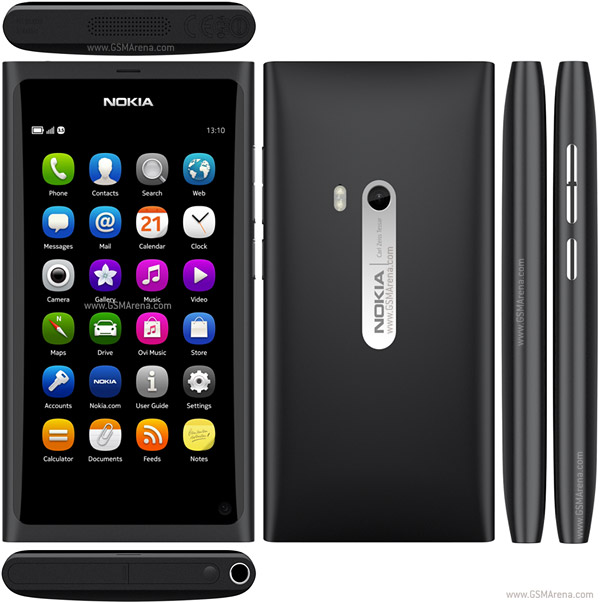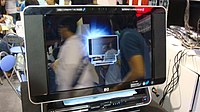The smartphone is notable for its backlit 4-rows
QWERTY keyboard and touch screen input methods, for its long battery life (Talktime : 7.5 to 14.8 h and Standby : 28 to 31 days),
[3] the out-of-the-box access to Microsoft Exchange ActiveSync, Microsoft Communicator Mobile and Microsoft SharePoint
[5] and the high pixel density of its VGA display (326ppi).
Like its predecessors (Nokia E71/E72), the Nokia E6-00 integrates a stainless steel and glass design.
[5] The back removable cover, the raised panel for the back camera, dual LED flash and loud speaker and the contour of the front are made of stainless steel. The front of the phone (except for the QWERTY keyboard, short cut buttons and Navikey) is covered with
Corning® Gorilla® Glass.
Its casing has three color options (black, silver and white).
The predecessor of the E6-00 in the Eseries, consisting of business-oriented smartphones, was the Nokia E72 which shipped in November 2009. As with the E71, the E72 received mostly praises from the press. It is worth noting that Nokia released the E7, a landscape QWERTY slider smartphone in the E-series based on Symbian^3, that shipped in February 2011.
The first hints that the Nokia E6-00 was being developed came, in early January 2011, from a Nokia XML and pictures from a Picasa album with pictures taken with the device. Various information could be retrieved from the XML such as the 8 MP camera, VGA display and QWERTY keyboard. The device was not officially announced at the Mobile World Congress held in Barcelona (14–17 February 2011). Various pictures and videos of the Nokia E6-00 leaked during the months of February and March.
It was officially announced at a special event, named Discover Symbian, on 12 April 2011 along with the Nokia X7 and the latest update of Symbian software. It is expected to be released in Q2 2011 in Europe at a price of €340 (before taxes and subsidies) and in Q3 2011 in North America.
The Nokia E6 is available at the Nokia Deutschland online shop for preorder at the price of €429. The Nokia E6-00 is powered by the same processor found in other recent Symbian devices such as the Nokia N8, E7 and C7, which is an ARM11 clocked at 680 MHz with a Broadcom BCM2727 GPU which supports OpenVG1.1 and OpenGL ES 2.0 support.The Nokia E6-00 has a 62.5 mm (diagonally) capacitive touchscreen with a resolution of 640 × 480 pixel (VGA, 326 ppi).[1] According to Nokia, it is capable of displaying up to 16.7M colours. The screen brightness of the E6-00 is "more than double the brightness of the E72" when measured in candelas.[13] There is a proximity sensor which deactivates the display and touchscreen when the device is brought near the face during a call.[1] The Nokia E6 also understands PictBridge protocol so it's possible to directly print from the phone to a printer without using a computer to handle the data transfer in between.
The optical Navi key of the E72 has been replaced by a Navi key on the E6-00.
[1] It has also an ambient light sensor that adjusts the display brightness and activates the backlit of the 4-row keyboard. A 3-axis accelerometer is present but will not switch the display to portrait mode when the device is turned sideways. It will, however, take pictures in portrait and show them the right way in the photo gallery.
[13]
The device has an autonomous
GPS with optional A-GPS functionality, Wi-Fi network positioning and Cell-ID and comes pre-loaded with the
Ovi Maps application. Ovi Maps for Symbian^3 provides: free life time, turn by turn, voice guided car and pedestrian navigation.
[1] If the map is already downloaded to the device, Ovi Maps does not require an active data connection and can work as a stand alone GPS navigator. For other services, for example
Google Maps, a data connection is required.
The 8 megapixel (3264 x 2448 px) back camera has an extended depth of field feature (no autofocus), dual LED flash, 2X digital zoom (3X in video mode) and offers high definition (720p, 16:9 aspect ratio) video recording at 25 frame/s or 4:3 aspect ratio.
[4] The 0.3 megapixel front camera is capable of video recording (176 x 144 px at 15 frame/s)
[2] for video calling.
The Nokia E6 has a loudspeaker and two microphones.
[2] The microphone at the front of the device collects voices of the user, another microphone at the back of the device collects environmental noise for active noise cancellation, which makes user's voice in noisy environment sound clearer to the person at the other end of the line. Noise cancellation is not available when using the loudspeaker or a headset.



















